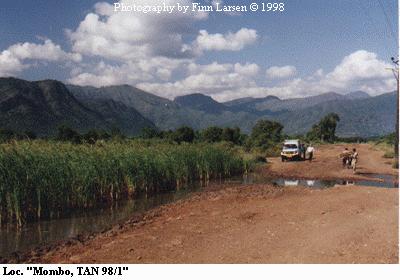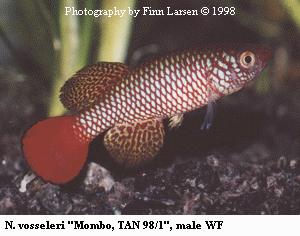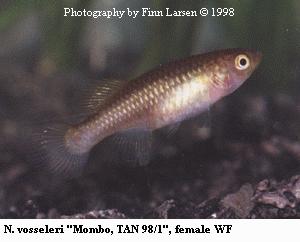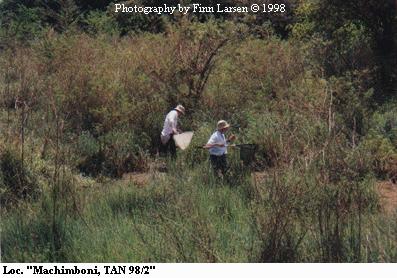
During the Belgium (AKFB) exhibition in Marcinelle in spring 1997, Mike Agnew and John Rosenstock decided that now it was their turn for a collecting trip to Tanzania. Back in Denmark John asked whether I would like to join them on such a trip. After some thoughts- mostly economic of course, as I have wished for a long time to take on such a trip – I said yes. Later Brian Watters also joined. After many conversations on the telephone and some overseas communication via email, we finished the various preparations to the trip.
Finally Saturday morning 16. May 1998 Brian Watters, Mike Agnew and I met in Schiphol airport in Amsterdam. Together we flew with KLM to Kilimanjaro airport in the northern Tanzania near Arusha.
 Sunday morning after one night on hotel Mountain Village - just outside Arusha - we went to Mellemfolkeligt Samvirke (MS), Danish Association for International Co-operation, trainingcenter in Tanzania (MS TCDC), east of Arusha to meet John Rosenstock. He had been in Zambia the last two weeks (official journey) and arrived also in Tanzania Saturday May 16.
Sunday morning after one night on hotel Mountain Village - just outside Arusha - we went to Mellemfolkeligt Samvirke (MS), Danish Association for International Co-operation, trainingcenter in Tanzania (MS TCDC), east of Arusha to meet John Rosenstock. He had been in Zambia the last two weeks (official journey) and arrived also in Tanzania Saturday May 16.
Our plan was to hire a car at MS TCDC. Due to misunderstandings the driver had a day off on Sunday and would not arrive before Sunday night. Therefore we used the day for planning our trip. Because of "El Nino" it has been raining a lot in the entire East-Africa; bridges and roads were washed away. An experience we had many times later on.
On Monday May 18. we took in supplies in Arusha and then we started chasing Nothobranchius.
The first days we spent in the north-eastern part of Tanzania - mainly in the area around Arusha and with trips into the Masai steppe. We also visited the "Manyara" locality. In spite of persistent fishing on many promising places we did not catch any Nothobranchius. On the "Manyara" locality we caught barbs and cichlids - species that neither Brian nor John had caught at that place before. But no Nothobranchius. Brian thought that the Nothobranchius simply were washed away because of too much rain.
 At two places in the area we visited offices for a Masai organization. At both places the people were very hospitable and very interested in what those "Mzungu" (europeans) were doing. The Masais knew where the fish were but either the localities were too far away or they were impossible to reach because of too much water. Not even with a Masai as guide did we find any Nothobranchius.
At two places in the area we visited offices for a Masai organization. At both places the people were very hospitable and very interested in what those "Mzungu" (europeans) were doing. The Masais knew where the fish were but either the localities were too far away or they were impossible to reach because of too much water. Not even with a Masai as guide did we find any Nothobranchius.
Thursday May 18. we reached Mombo. We were told that the road to the airport was washed away but nevertheless we reached the place that probably is the typelocality of N. vosseleri. At last we caught our first Nothobranchius.
N. vosseleri "Mombo, TAN 98/1". Apperently, there were a lot of fish and soon we had caught all the fishes we needed.
On the way along, we stopped at the "Mombo, TAN 95/19" locality south of Mombo to take a GPS-position; we did not go fishing.
 Then we went to Tanga where we decided to stay for the next two nights.
Then we went to Tanga where we decided to stay for the next two nights.
The following day was dedicated to the search for Nothobranchius on the Umbra steppe north-west of Tanga. Already on the outskirts of Tanga, Brian would fish in some small ponds close to a river. In 1995 Brian, Ian Sainthouse and Ruud Wildekamp had caught Pantanodon podoxys in this locality. Immediately some local people hastened to the spot. They pointed on the water surface and said "Mombo, mombo". Our driver told us that it meant 'crocodile'. After all we did not see the crocodile and unfortunately neither some Pantanodon podoxys. However, Brian caught some glasperches.
North-west of Tanga near Machimboni we caught Nothobranchius again - this time N. melanospilus and N. palmqvisti. Unfortunately the N. palmqvisti's were in a bad condition and looked ill. Later on we lost most of them and out of 12 couples only one male and three females were alive when we left Tanzania. Luckily we had more success with the N. melanospilus from this locality - and moreover with the fish from all other localities. This locality got the name "Machimboni, TAN 98/2".
Unfortunately, we could not cross the Umba river, again because of too much water. Therefore we had to return along the same road to Tanga.


 Next day we went to the west again. Between Segara and Korogwe - near Mandera - we caught N. vosseleri again, this time in a roadside ditch. The locality was given the name "Mandera, TAN 98/3".
Next day we went to the west again. Between Segara and Korogwe - near Mandera - we caught N. vosseleri again, this time in a roadside ditch. The locality was given the name "Mandera, TAN 98/3".
 On our way towards Morogoro we passed many promising localities where N. melanospilus probably would be present too. But since it was so late we had to drive directly to Morogoro. We took lodgings at Morogoro Hotel. Again for two nights as we planned to use the next day in the area west of Morogoro. The hotel was something special. The main building is a big circular and open house, and everywhere grasshoppers were present attracted by the light. At night time a noisy discotheque was running. The beds were much too short. The hotel also had a swimming pool - probably without water for the last 10-15 years. In the restaurant 90 % of the stuff on the menu card was not available. Otherwise, it was a very cosy place.
On our way towards Morogoro we passed many promising localities where N. melanospilus probably would be present too. But since it was so late we had to drive directly to Morogoro. We took lodgings at Morogoro Hotel. Again for two nights as we planned to use the next day in the area west of Morogoro. The hotel was something special. The main building is a big circular and open house, and everywhere grasshoppers were present attracted by the light. At night time a noisy discotheque was running. The beds were much too short. The hotel also had a swimming pool - probably without water for the last 10-15 years. In the restaurant 90 % of the stuff on the menu card was not available. Otherwise, it was a very cosy place.
 The next day we went westwards. At lunch time we arrived at Dodoma. We continued to the south towards Iringa to fish at the "Chipogola" locality. After some searching we succeeded in finding the "Chipogola" locality. But first, the road was being built further away from the lake that made it difficult to approach the lake. Second, the lake was enormous because of the heavy rainfall. Although we tried we did not catch any N. neumanni. On the way back to Dodoma we fished at a few places but without success. In Dodoma we stayed at Dodoma Hotel - again for two nights. Though the Dodoma Hotel should be the best hotel in town it was rather run down - but cheap.
The next day we went westwards. At lunch time we arrived at Dodoma. We continued to the south towards Iringa to fish at the "Chipogola" locality. After some searching we succeeded in finding the "Chipogola" locality. But first, the road was being built further away from the lake that made it difficult to approach the lake. Second, the lake was enormous because of the heavy rainfall. Although we tried we did not catch any N. neumanni. On the way back to Dodoma we fished at a few places but without success. In Dodoma we stayed at Dodoma Hotel - again for two nights. Though the Dodoma Hotel should be the best hotel in town it was rather run down - but cheap.
 Tuesday May 26. we deided to spend in the area west of Dodoma. Three km west of Bahi we caught the first Nothobranchius of the day in a rather deep ditch with a connection to a little water pond on the other side of the road via a culvert. We caught N. taeniopygus and N. neumanni. In spite of the rather intense fishing on the locality we caught only very few fishes and we could not see any difference in the females. The locality was named "Bahi, TAN 98/5".
Tuesday May 26. we deided to spend in the area west of Dodoma. Three km west of Bahi we caught the first Nothobranchius of the day in a rather deep ditch with a connection to a little water pond on the other side of the road via a culvert. We caught N. taeniopygus and N. neumanni. In spite of the rather intense fishing on the locality we caught only very few fishes and we could not see any difference in the females. The locality was named "Bahi, TAN 98/5".
 We fished at a number of places in area west of Dodoma and we found another Nothobranchius locality too. Here we caught a N. neumanni male and furthermore a Nothobranchius species which probably is unknown. No differences on the females could be seen. The following breeding will show whether there are females of both species. This locality was named "Tangawizi, TAN 98/7".
We fished at a number of places in area west of Dodoma and we found another Nothobranchius locality too. Here we caught a N. neumanni male and furthermore a Nothobranchius species which probably is unknown. No differences on the females could be seen. The following breeding will show whether there are females of both species. This locality was named "Tangawizi, TAN 98/7".




 The next day we went south towards Ndundu at the Rufiji River. We had decided to cross the Rufiji River to fish south of the river at the locality "Kitonga North, TAN 97/9" where Cooper, Wildekamp and Watters in 1997 - among other things - caught the newly described species N. fuscotaeniatus.
The next day we went south towards Ndundu at the Rufiji River. We had decided to cross the Rufiji River to fish south of the river at the locality "Kitonga North, TAN 97/9" where Cooper, Wildekamp and Watters in 1997 - among other things - caught the newly described species N. fuscotaeniatus.


 The trip continued to the south and just south of Ruhoi River we stopped to fish again. At some distance from the road between trees, scrubs and high grass we found a small pool (4 x 2 metres and 20-25 cm deep). The first Nothobranchius was caught very quickly. A short time after we had caught
N. melanospilus, N. janpapi, N. eggersi, N. annectens, N. ocellatus, Aplocheilichtys kongoranensis, Ctenopoma muriei together with barbs and cichlids - however, only a few specimens of each species and this probably because of N. ocellatus. John thought that it looked like a beginner's aquarium with two fish of one species and three fish of another species. It was a very fascinating place with five Nothobranchius species at the same pool and I had the opportunity to visit a real N. ocellatus locality. We succeed in catching three males and two females of N. ocellatus, four Ctenopoma muriei and 1-1 ½ m from the pool we found a very shallow pool - 1 x 0.3 metres and 2-3 cm deep covered by high grass - where some N. eggersi had taken refuge for the predators in the pool. From this locality we took these three species. Among the rest of the species we only succeeded in catching very few specimens and we took none of these with us. The locality is named "Ruhoi River, TAN 98/11".
The trip continued to the south and just south of Ruhoi River we stopped to fish again. At some distance from the road between trees, scrubs and high grass we found a small pool (4 x 2 metres and 20-25 cm deep). The first Nothobranchius was caught very quickly. A short time after we had caught
N. melanospilus, N. janpapi, N. eggersi, N. annectens, N. ocellatus, Aplocheilichtys kongoranensis, Ctenopoma muriei together with barbs and cichlids - however, only a few specimens of each species and this probably because of N. ocellatus. John thought that it looked like a beginner's aquarium with two fish of one species and three fish of another species. It was a very fascinating place with five Nothobranchius species at the same pool and I had the opportunity to visit a real N. ocellatus locality. We succeed in catching three males and two females of N. ocellatus, four Ctenopoma muriei and 1-1 ½ m from the pool we found a very shallow pool - 1 x 0.3 metres and 2-3 cm deep covered by high grass - where some N. eggersi had taken refuge for the predators in the pool. From this locality we took these three species. Among the rest of the species we only succeeded in catching very few specimens and we took none of these with us. The locality is named "Ruhoi River, TAN 98/11".











 South of Mbezi River we fished again and this time we got a few N. albimarginatus. However, we did not take any of them away as we were told where to go for more fish. We found the place quickly, a shallow pool with many waterlilys. Here we caught N. albimarginatus again and also N. annectens. The locality is called "Kiparagande, TAN 98/13" after the nearby village Kiparagande.
South of Mbezi River we fished again and this time we got a few N. albimarginatus. However, we did not take any of them away as we were told where to go for more fish. We found the place quickly, a shallow pool with many waterlilys. Here we caught N. albimarginatus again and also N. annectens. The locality is called "Kiparagande, TAN 98/13" after the nearby village Kiparagande.

 All my 100 specimen of fish survived the trip home.
All my 100 specimen of fish survived the trip home.
